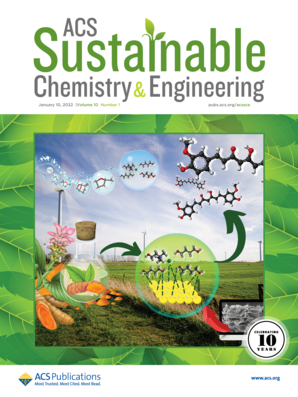Polydopamine-Cross-Linked Enzyme Aggregates: Overcoming Activity Inhibition by Heavy Metals and Their Recovery and Reuse
IF 7.1
1区 化学
Q1 CHEMISTRY, MULTIDISCIPLINARY
引用次数: 0
Abstract
Chemical industry wastewater contains toxic organic and inorganic species. To remove these pollutants, enzyme-based methods have attracted wide attention because of their merits such as mild operating conditions, low energy consumption, reduced byproducts, and low toxicity. However, the inhibition of enzymatic activity by heavy metals due to the metal–enzyme interactions limits their applications in wastewater treatment. To tackle this challenge, here we have developed polydopamine (PDA)-cross-linked enzyme aggregates (PCLEAs), in which enzyme aggregates were in situ cross-linked through the formation of imine bonds or/and Michael addition reactions. PDA exhibited a higher affinity for heavy metals compared to enzymes, resulting in improved enzyme activity and recovery and reuse of heavy metals to afford PCLEA containing heavy metals (PCLEA-HMs). Several PCLEA-HMs were synthesized through combinations of enzymes, including lipase and glucose oxidase (GOx), and heavy metals, including Pd, Pt, Au, Ag, Mn, and Zn salts. Their structures and catalytic properties were systematically studied to obtain a better understanding of structure–activity relationships. Additionally, the photothermal effect of polydopamine could promote catalytic performance, contributing to enhanced activity under irradiation. The PCLEA-HMs could be utilized for the cascade degradation of 4-nitrophenyl acetate and the detection of phenol. This strategy advances the development of PCLEA-HMs for practical chemical wastewater treatment.

聚多巴胺-交联酶聚集体:克服重金属的活性抑制及其回收和再利用
化工废水中含有有毒的有机和无机物质。酶法因其操作条件温和、能耗低、副产品少、毒性低等优点而受到广泛关注。然而,由于金属-酶的相互作用,重金属对酶活性的抑制限制了它们在废水处理中的应用。为了应对这一挑战,我们开发了聚多巴胺(PDA)-交联酶聚集体(PCLEAs),其中酶聚集体通过形成亚胺键或/和Michael加成反应原位交联。与酶相比,PDA对重金属表现出更高的亲和力,从而提高了酶的活性,提高了重金属的回收和再利用能力,从而获得了含重金属的PCLEA (PCLEA- hms)。通过脂肪酶和葡萄糖氧化酶(GOx)等酶和钯、铂、金、银、锰、锌等重金属盐的组合,合成了几种PCLEA-HMs。系统地研究了它们的结构和催化性能,以更好地了解它们的构效关系。此外,聚多巴胺的光热效应可以促进催化性能,有助于增强辐照下的活性。PCLEA-HMs可用于4-硝基苯乙酸的级联降解和苯酚的检测。这一策略促进了用于实际化学废水处理的PCLEA-HMs的发展。
本文章由计算机程序翻译,如有差异,请以英文原文为准。
求助全文
约1分钟内获得全文
求助全文
来源期刊

ACS Sustainable Chemistry & Engineering
CHEMISTRY, MULTIDISCIPLINARY-ENGINEERING, CHEMICAL
CiteScore
13.80
自引率
4.80%
发文量
1470
审稿时长
1.7 months
期刊介绍:
ACS Sustainable Chemistry & Engineering is a prestigious weekly peer-reviewed scientific journal published by the American Chemical Society. Dedicated to advancing the principles of green chemistry and green engineering, it covers a wide array of research topics including green chemistry, green engineering, biomass, alternative energy, and life cycle assessment.
The journal welcomes submissions in various formats, including Letters, Articles, Features, and Perspectives (Reviews), that address the challenges of sustainability in the chemical enterprise and contribute to the advancement of sustainable practices. Join us in shaping the future of sustainable chemistry and engineering.
 求助内容:
求助内容: 应助结果提醒方式:
应助结果提醒方式:


